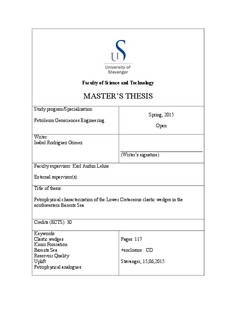| dc.contributor.author | Rodriguez, Isabel | |
| dc.date.accessioned | 2015-09-17T11:56:24Z | |
| dc.date.available | 2015-09-17T11:56:24Z | |
| dc.date.issued | 2015-06-15 | |
| dc.identifier.uri | http://hdl.handle.net/11250/300545 | |
| dc.description | Master's thesis in Petroleum geosciences engineering | nb_NO |
| dc.description.abstract | The results of the petrophysical evaluation of four turbidite systems located along the flanks of the Hammerfest Basin, in the southwestern Barents Sea, are presented in this master thesis. These systems are the reservoir of the Lower Cretaceous Clastic Wedges play in this area, which was proven successful in 2012, after drilling the Salina prospect. An environmental analysis, based on the study of cores and logs, shows that sand rich turbidite systems might be expected on the northeastern flanks of the Hammerfest Basin, sourced from the eastern Loppa High. Towards the northwestern and southwestern flanks, sand-mud rich system, sourced from the Loppa High and Finnmark Platform, are expected. This analysis, together with the results from the petrophysical evaluation, suggests a direct dependency of reservoir quality on depositional environment as well as on the type of turbidite system.
A main challenge regarding petrophysical evaluations of these reservoirs is the scarce core data available within the Lower Cretaceous stratigraphic unit. Core data are very important for calibration of the parameters needed for the computation of the reservoir properties. The wells used in this study are among the few with core data available so the results could be calibrated. Therefore, these turbidite systems are proposed as analogues for future petrophysical evaluations of the Lower Cretaceous
vii
sandstone wedges when core data are not available. However, care should be taken in the use of these analogues since differences in the turbidites source area affect some of the petrophysical calculations. The results show that the computing parameters for the calculation of Vcl and PHIE/PHIT might be used independently from the reservoir’s source area. Yet, for permeability calculations, source area should be taken into consideration. | nb_NO |
| dc.language.iso | eng | nb_NO |
| dc.publisher | University of Stavanger, Norway | nb_NO |
| dc.relation.ispartofseries | Masteroppgave/UIS-TN-IPT/2015; | |
| dc.subject | petroleumsgeologi | nb_NO |
| dc.subject | Barents Sea | nb_NO |
| dc.subject | Knurr Formation | nb_NO |
| dc.subject | Clastic wedges | nb_NO |
| dc.subject | Barentshavet | nb_NO |
| dc.subject | petrophysical characterization | nb_NO |
| dc.title | Petrophysical characterization of the Lower Cretaceous clastic wedges in the northwestern Barents Sea | nb_NO |
| dc.type | Master thesis | nb_NO |
| dc.subject.nsi | VDP::Technology: 500::Rock and petroleum disciplines: 510::Geological engineering: 513 | nb_NO |
| dc.subject.nsi | VDP::Mathematics and natural science: 400::Geosciences: 450::Petroleum geology and petroleum geophysics: 464 | |
